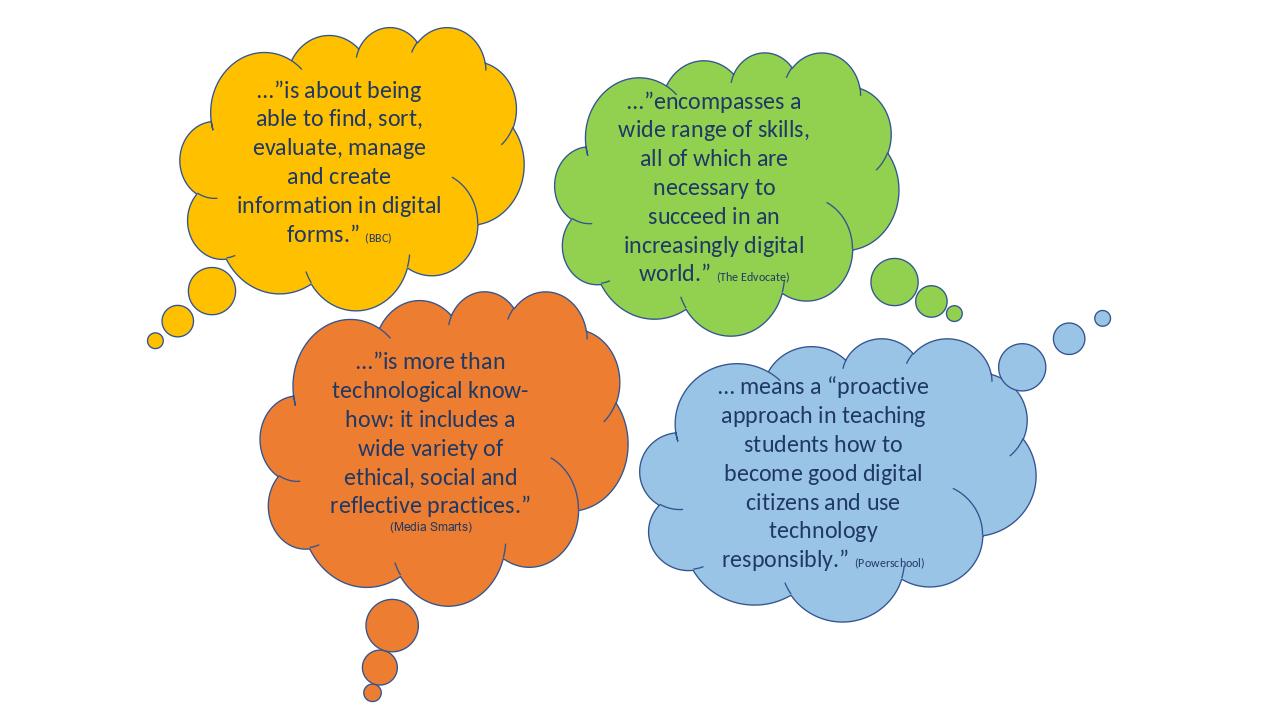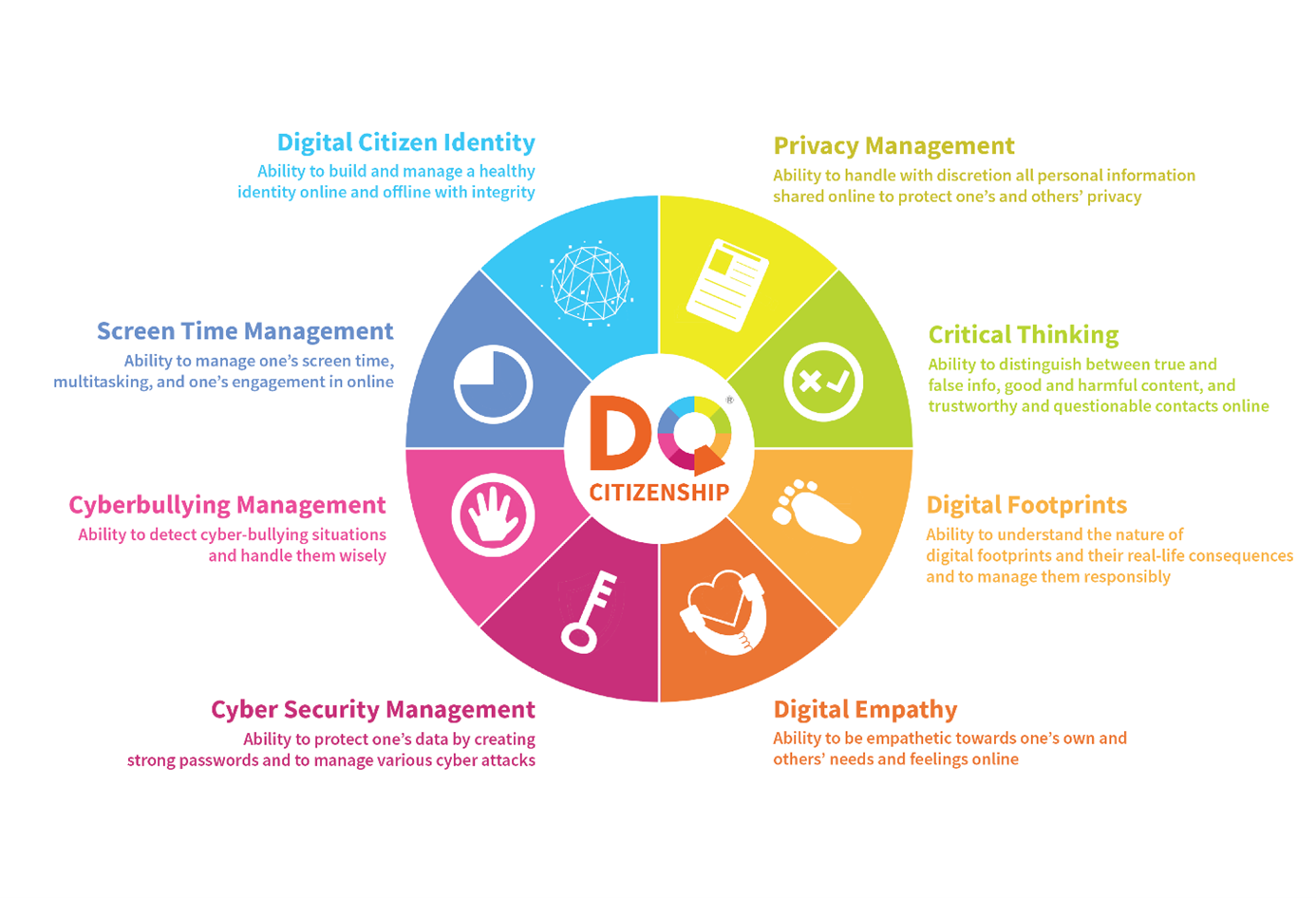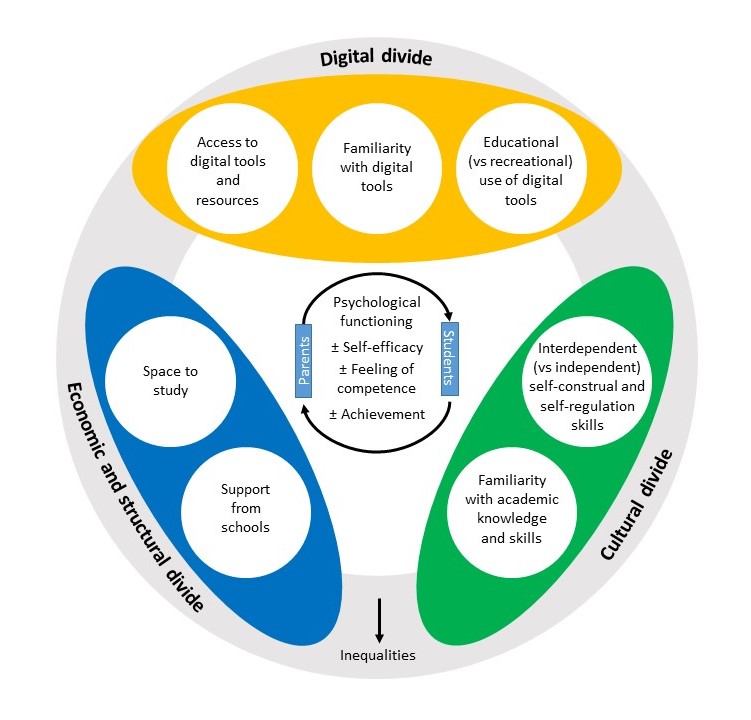Section outline
-
Welcome to the first module.
In this module you will
- find out more about the concept of Digital Literacy
- understand, why it is important in the context of education and teaching
- get to know skills to improve your Digital Literacy skills as well as strengthen Digital Literacy Citizenship among your students
- strengthen awareness of inequalities among students concerning Digital Literacy
-
What is Digital Literacy?
For a first introduction please see the video below:
Digital literacy and why it matters (2:54 Min): University of Derby (2014): Digital literacy and why it matters. [1]
The Video is only available in English. Subtitles can be turned on on YouTube. The video explains what "digital literacy" means and why it is important.
-
As you saw in the video, Digital Literacy describes a number of skills and competences that are important in an increasingly digital world. But it's not just about technological know-how. See below various definitions of Digital Literacy to get a clearer image of what it means.
Digital Literacy: What it means to be is described in the following graphic:
-
 Figure 1: Digital Literacy. BBC [2], The Edvocate [3], Media Smarts [4], Powerschool [5]
Figure 1: Digital Literacy. BBC [2], The Edvocate [3], Media Smarts [4], Powerschool [5] -
Digital Literacy in Education
-
Referred to education, Digitial Literacy is extremely important
- for students:
Apart from other important qualifications, students need to have a number of Digital Literacy skills in order to face the increasing amount of digital requirements in our society. On the one hand this refers to working environments - students need to be prepared for more and more digital labour conditions. On the other hand it also includes lots of aspects of everyday life - it is important to learn, how to move in the digital space in a responsible way. See in the table below what digital citizenship means to be.
- for teachers:
Today´s teachers need to equip themselves with the digital skills that are necessary to help their students to become responsible digital citizens. This requires technical know-how on the one hand but it goes far beyond that as it demands knowledge about opportunities, risks and dangers referred to the digital world, as well as a set of competences in how to encourage and empower students to be responsible citizens - online as well as offline.
At the same time, digital tools are more and more used for teaching. It is important to constantly analyse and criticially reflect those tools concerning topics like inclusiveness, representation and stereotypes.
-
Becoming A Digital Citizen – What Does That Mean?

Figure 2: DQ Digital Citizenship Framework [6]
-
As you can see in figure 2, there are various aspects of Digital Citizenship. Considering the different areas, one can notice that they are connected with each other. Critical thinking skills are needed for example in order to overthink one´s digital footprint and to manage cyber security. (Digital) Empathy is needed to teach people how to react when being exposed to cyberbullying situations.
-
Wir alle sind verantwortlich für die Art und Weise, wie wir handeln. Das gilt auch für die digitale Umgebung. Ein verantwortungsbewusster Umgang damit ist entscheidend für eine Atmosphäre des Wohlbefindens, des Vertrauens und des Respekts - uns selbst und den Menschen um uns herum gegenüber.

Figure 3: Digital Responsibility
-

Reflexion
- Wenn Sie an Ihre Schule / Ihre Klasse / Ihre Schüler:innen denken, in welchen Bereichen sehen Sie einen hohen Handlungsbedarf? Wenn möglich, diskutieren Sie Ihre eigenen Wahrnehmungen anschließend mit Ihren Kolleg:innen.
-

Sie müssen keine Profis für alle Themen sein. Es kann sehr nützlich sein, Expert:innen in bestimmten (lokalen) Organisationen zu suchen, die Workshops anbieten, Vorträge halten oder Materialien an Ihrer Schule verteilen können. Weitere Informationen finden Sie bei diesen Organisationen:
Online Sicherheit: Online Safety Alliance
Hate Speech: No Hate Speech Movement
-
Digital Divide und Digital Accessibility
„Der Begriff “digitale Kluft" bezieht sich auf die Kluft zwischen Einzelpersonen, Haushalten, Unternehmen und geografischen Gebieten auf unterschiedlichen sozioökonomischen Ebenen sowohl hinsichtlich ihrer Möglichkeiten des Zugangs zu Informations- und Kommunikationstechnologien (IKT) als auch hinsichtlich ihrer Nutzung des Internets für eine Vielzahl von Aktivitäten.
- OECD 2006 [10]
Die COVID-19-Pandemie zwang die Lehrenden zur Umstellung auf Fernunterricht und digitale Hilfsmittel, was zahlreiche Herausforderungen mit sich brachte. Lehrkräfte, Schüler:innen und Eltern mussten sich schnell an diesen neuen Bildungskontext anpassen. Aufgrund der bereits vorher bestehenden sozialen Ungleichheiten drohten der Fernunterricht und die zunehmende Nutzung digitaler Hilfsmittel die akademischen Ungleichheiten unter den Schüler:innen zu verstärken.

Figure 5: How digital technologies contribute to social inequalities [11].
-
Digital technologies can reinforce social inequalities that already existed in society. Figure 5 shows this interrelation: different dimensions like sex/gender, origin, class, age, religion, disability have influence on the access and especially the economic and social resources, as well as discrimination patterns. At the same time, the design of digital products can lead to exclusion. This can happen through stereotyped presentations (e.g. pink for girls, blue for boys), a lack of representation and diversity or a design that doesn’t meet people`s needs, which can lead to a spiral of inequality, which then again has impacts on socialization.
-

Figure 6: Social inequality processes during school closure. Economic, structural, digital and cultural divides influence the psychological functioning of parents and students in a way that amplify inequalities [12].
-
Figure 6 shows the digital divide in the context of a cultural, economic and structural divide. All in all, these different aspects affect self-efficacy, the feeling of competence and achievement and finally lead to inequalities.
For a better understanding, please download and read the whole article below:
-
The document is only available in english. The COVID-19 pandemic has forced teachers and parents to quickly adapt to a new educational context: distance learning. Teachers developed online academic material while parents taught the exercises and lessons provided by teachers to their children at home. Considering that the use of digital tools in education has dramatically increased during this crisis, and it is set to continue, there is a pressing need to understand the impact of distance learning. Taking a multidisciplinary view, we argue that by making the learning process rely more than ever on families, rather than on teachers, and by getting students to work predominantly via digital resources, school closures exacerbate social class academic disparities.
-
Reflection
What do you think ?
- What can you as a teacher do to reduce the digital divide between students?
- What can your school do?
- Where do you see limitations and difficulties?
-
European Framework for The Digital Competence of Educators
´As educators face rapidly changing demands, they require an increasingly broader and more sophisticated set of competences than before. In particular, the ubiquity of digital devices and the duty to help students become digitally competent requires educators to develop their own digital competence.´ (DigCompEdu 2017, S.4 [7])
The European Comission published a European Framework for the Digital Competence of Educators [7]. It describes a number of tools and trainings for educators to develop their digital competences.
Here you can find the entire publication:
-
The document is only available in english. The ubiquity of digital devices and the duty to help students become digitally competent requires educators to develop their own digital competence. This report presents a common European Framework for the Digital Competence of Educators (DigCompEdu). The DigCompEdu framework is directed towards educators at all levels of education, from early childhood to higher and adult education, including general and vocational education and training, special needs education, and non-formal learning contexts.
-
See here a video that introduces the Digital Competence Framework for Educators (DigCompEdu) [8]:
European Framework for the Digital Competence of EducatorsTeaching in the digital age - using technology to enhance learning (2:35 Min):The video is only available in english. Subtitles are available. The video documents the importance of the European Framework for the Digital Competence of Educators and explains its main characteristics: the pillars of educators’ digital competence, the education sectors it refers and the progression path educators may follow towards their digital competence. It finally introduces the free online tool, that is under way, which will enable educators to reflect on their digital skills. -

Figure 4: DigCompEdu, 6 areas of digital competences [9]
-
The DigCompEdu Framework pointed out six different areas of competences that focus on varied aspects of educators’ professional activities. We now want to have a deeper look into these aspects.
Task 1:
Please open the European Framework for the Digital Competence of Educators. You will first get a brief overview over the document. Then open the six documents below which you can work through step by step. Each document includes a little reading task as well as questions to reflect on. Take notes and share your thoughts with your colleagues.
-
Sources
[1] University of Derby (2014): Digital literacy and why it matters. Online available: https://www.youtube.com/watch?v=p2k3C-iB88w&ab_channel=UniversityofDerby
[2] BBC. Welsh Baccalaureate (WBQ National: Foundation KS4). Digital Literacy. Online available: https://www.bbc.co.uk/bitesize/guides/zxs2xsg/revision/1
[3] Lynch, Matthew (2017): What is Digital Literacy? In: The Edvocate. Online available: https://www.theedadvocate.org/what-is-digital-literacy/
[4] Media Smarts. Canada´s Centre for Digital and Media Literacy. Digital Literacy Fundamentals. Online available: https://mediasmarts.ca/digital-media-literacy/general-information/digital-media-literacy-fundamentals/digital-literacy-fundamentals
[5] Powerschool (2021): The Classroom Guide to Digital Literacy in K-12 Education. Online available: https://www.powerschool.com/resources/blog/the-classroom-guide-to-digital-literacy-in-k-12-education/
[6] White Paper Digital Intelligence (DQ) (2017): A Conceptual Framework & Methodology for Teaching and Measuring Digital Citizenship. Online available: https://www.dqinstitute.org/wp-content/uploads/2017/08/DQ-Framework-White-Paper-Ver1-31Aug17.pdf
[7] Redecker, C. (2017): European Framework for the Digital Competence of Educators: DigCompEdu. Punie, Y. (ed). Publications Office of the European Union. doi:10.2760/159770
[8] European Union (2021): European Framework for the Digital Competence of Educators Teaching in the digital age - using technology to enhance learning. Online available: https://audiovisual.ec.europa.eu/en/video/I-201842?lg=EN%2FEN
[9] Joint Research Centre. Digital Competence Framework for Educators (DigCompEdu). Online available: https://joint-research-centre.ec.europa.eu/digcompedu_en
[10] OECD (2006): Glossary of Statistical Terms. Digital Divide. Online available: https://stats.oecd.org/glossary/detail.asp?ID=4719
[11] Reidl, Sybille; Streicher Jürgen; Hock, Marlene; Hausner, Beatrix; Waibel, Gina; Gürtl, Franziska (2020): Digitale Ungleichheit. Wie sie entsteht, was sie bewirkt und was dagegen hilft. Wien: Österreichische Forschungsförderungsgesellschaft mbH (FFG). Online available: https://www.femtech.at/content/digitale-ungleichheit-wie-sie-entsteht-was-sie-bewirkt-und-was-dagegen-hilft.
[12] Goudeau, S., Sanrey, C., Stanczak, A. et al. Why lockdown and distance learning during the COVID-19 pandemic are likely to increase the social class achievement gap. Nat Hum Behav 5, 1273–1281 (2021). https://doi.org/10.1038/s41562-021-01212-7
